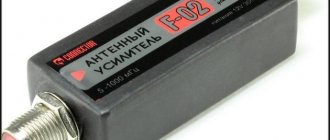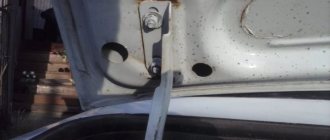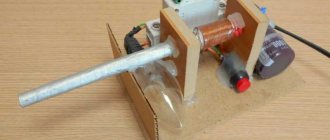Do-it-yourself electronic automation circuits for home and everyday life
To ensure a comfortable stay, it is necessary to use automation. Radio amateurs offer a lot of useful electronic circuits for home and everyday life. However, in some sources there are circuit diagrams that do not work at all, and you have to spend time improving them. The reason is the lack of a full description of the operating principle and a list of parts.
How to make a smart home
You can make an intelligent system with your own hands; the most budget-friendly option is to set up control of lighting in the house or turn on a computer.
Photo - Smart home control option
To make a lamp that will light up on its own, you will need to connect special equipment to it. There are several options for solving this problem:
- Install an acoustic relay (1 or x10-wire);
- Attach the dimmer;
- Connect a motion sensor.
The easiest way to work is with a sensor. It is sold in any online store, you can buy a duct device, or you can develop your own according to your parameters. The only note is that you cannot install an incandescent lamp with such a device, it may not withstand the load and explode, it is better to work with an LED one.
- What is a smart home system and an example of its implementation
Photo – Smart home concept
Another “smart” silent option is a dimmer. Here you will need to touch the lamp, depending on the number of touches, the speaking device will change brightness. This is very convenient to use on a lamp in a bedroom or children's room.
To set up temperature control and regulation, we need a multi-channel system. The central temperature and humidity control circuit consists of:
- Sensors (ds1820) that measure the physical state of liquid and air.
- Controllers (rfm12), which can be simple physical components to complex special-purpose devices or embedded computers.
- Lunex drives that respond to controller signals.
The most modern way is to buy all the components of a smart home, wires, thermostats. Then install devices in each room, one thermostat for the radiator and one for the boiler. You will also need a controlled unit, or the “brain” of the entire system. It is recommended to install it on the heating inlet pipe.
Photo – Smart home system
The easiest way to install a video surveillance and alarm system. Fundamental provisions for installing security systems:
- You need to connect sensors on windows and doorways, where the electrics will be the most productive;
- The most difficult thing is to select a board; the smart home controller, the operation of mediocre parts, and the signal level depend on it;
- Many experts believe that indicators should be mounted at floor level. About 20 cm from the baseboard, this increases efficiency;
- It is advisable to establish constant monitoring and establish a digital system of contact with the security service. Often, responsible owners install a special program on their personal computer, which allows them to control the operation of the system from anywhere where there is Internet (Elena Tesla and her book: “Smart Home: How to Do It Yourself” advises doing this; there are also other solutions there ). You can enable SMS notifications.
A smart home is a very convenient way to make your life easier; often the entire system is purchased completely (Arduino, KNX, Linux).
The cost of each system is individual. The most popular brands are the following: beckhoff, gira, lpt, redeye, Smart Switch IOT screen, teleco. We recommend that before building such housing, you consult with specialists; they will help you calculate the load level and calculate the power consumption.
Photo - Light control via phone
To get ideas, you can look through V.N. Gololobov’s “Smart Home” with your own hands, DJVU or PDF, look at our photos and video instructions for free, and read advice from famous masters.
Bookshelf loudspeaker Castle Richmond IV
- Security alarm system for an industrial facility based on various types of sensors (page 2 of 18)
The Castle Richmond IV is a 2-way bass reflex model that represents the rich heritage of one of Britain's finest loudspeaker manufacturers.
Bowers&Wilkins CCM7.3 S2 - in-ceiling 3-way speaker system
The CCM7.3 S2 is a high-quality in-ceiling 3-way speaker system capable of operating in stereo systems and the highest-end home theater environments.
Bowers&Wilkins CCM7.5 S2 - in-ceiling 2-way speaker system
The CCM7.5 S2 is a high quality in-ceiling 2-way speaker system capable of operating in stereo systems and home theaters.
Bowers&Wilkins ASW608 – active subwoofer
In the new 600 Series subwoofers, the bass driver cones are also constructed from a precisely selected mixture of paper pulp...
Bowers&Wilkins ASW610XP – active subwoofer
In the new 600 Series subwoofers, the bass driver cones are also constructed from a precisely selected mixture of paper pulp...
Sound United announces termination of agreement to acquire Onkyo Corporation's audio division
Vista, California. (October 4, 2022) - in mid-May 2019, Sound United LLC announced the signing of an agreement for...
PS Audio Windom - operating system update for DirectStream DAC
PS Audio has announced the release of Windom, the seventh operating system update for its DirectStream DAC.
Firmware update for MOBOTIX Mx6 series video cameras
The firmware update will provide the following additional improvements...
Sonos makes integration with Control4 easier
The American online magazine “Sound and Vision” (Jul 12, 2019) published news about simplifying the integration of Sonos and Control4 products.
Bowers & Wilkins PI3 - in-ear wireless headphones
Headphones may become miniature, but music never...
Bowers & Wilkins PX5 - Over-Ear Wireless Noise Canceling Headphones
Lightweight and compact, the PX5 delivers sound quality that meets Bowers & Wilkins' most stringent standards.
Bowers & Wilkins PX7 - Closed Wireless Noise Canceling Headphones
Bowers & Wilkins PX7 headphones take sound quality to new heights...
Bowers & Wilkins Introduces a Family of Most Advanced Wireless Headphones
Get rid of the noise and dive deeper into the music...
ONKYO TX-8270 - many functions in one stylish, modern case
The German online magazine “hifi-journal.de” (04. September 2019) published a test of the Onkyo TX-8270 stereo receiver.
Francis Ford Coppola at SIM2 headquarters!
The five-time Oscar winner wanted to see with his own eyes the level of HDR that only the world's only SIM2 DUAL NERO 4S system can provide
PS Audio DirectStream DAC - Highly Recommended
The audiophile online magazine “audiophilestyle” published an article about the PS Audio DirectStream DAC with the Snowmass software version
USB DAC AudioQuest DragonFly Cobalt - tangible progress in all aspects
The What Hi-Fi magazine (10th Sept 2019) published a test of the AudioQuest DragonFly Cobalt USB DAC.
Bowers & Wilkins 702 S2 - Get the most bang for your pounds, crowns or dollars
The online magazine “Ear” (September 25, 2018) published a test of the Bowers & Wilkins 702 S2 speaker systems.
TEAC NR-7CD - well worth the price
The Swiss magazine AV Guide published a test of the network CD player/integrated amplifier TEAC NR 7CD.
SIM2 company at the international exhibition CEDIA 2019
At the international exhibition CEDIA 2022, SIM2 will not just show two of its new products, but will present two fundamentally innovative CONCEPTS!
All news
To ensure a comfortable stay, it is necessary to use automation. Radio amateurs offer a lot of useful electronic circuits for home and everyday life. However, in some sources there are circuit diagrams that do not work at all, and you have to spend time improving them. The reason is the lack of a full description of the operating principle and a list of parts.
Content
General information about automation
Automation refers to mechanisms, instruments and devices that operate or control the operation of other components without human intervention. It is used in almost all areas: in enterprises and at home. To increase the reliability and productivity of equipment, it is necessary to eliminate as much as possible the factor of human actions that affects the result of the work. Automation can significantly improve the quality of life by freeing people from routine work.
Automation also makes it possible to prevent accidents in any industry that threaten equipment, life and health of people. The last two reasons for the use of automation tools are very important, since they help ensure a high level of safety in the enterprise. This is very important not only for the employer, but also for the employees.
It is necessary to constantly monitor the operation of electronics, as they may fail. Due to the high efficiency of devices, automation in everyday life has become widespread among craftsmen.
Smart home - what is it?
Smart home refers to home automation, which is a residential extension of building automation. Home automation can include centralized control of lighting, HVAC (heating, ventilation and air conditioning), home appliances, gate openers, door openers, GSM and other systems to provide improved convenience, comfort, energy efficiency and security. It should be noted that for some categories of the population (elderly, disabled people) this event may become necessary.
Photo – Smart home distribution ideas
The maintenance of the house directly depends on the needs of the owners. Despite all the advertising campaigns, the security of the systems is greatly exaggerated. There is a heavy load on the electrical panel, this can be dangerous if the wiring in the apartment is weak. Kulakov advises to start by changing the entire wiring.
Photo – Simple smart home
With the latest introduction of SMART technologies into our lives, many can no longer imagine their lives without automatic installations, software equipment; we need wireless Internet and household appliances.
Home automation refers to the use of computer and information technology to control home appliances and their functions. It can range from simple remote lighting control to complex computer/micro-controller based networks with varying degrees of intelligence and automation. Home automation should mainly be as simple as possible.
Photo – Smart door lock
Advantages of using a “smart home” in an apartment based on PIC or WAVE:
- Economical expenditure of time on daily setup of various mechanisms, receiving calls, sending mail;
- The use of gaseous or liquid fuels, and later the use of electricity, allowed increased automation in heating systems, reducing the labor required to manually refill the heater and furnace.
- The development of thermostats allowed for more automated control of heating, and later cooling;
- This is how industrial facilities and residential premises are often protected;
- As the number of controlled devices in a home increases, their interconnection increases. For example, a furnace can send notifications when it needs cleaning, or a refrigerator when it needs servicing.
- In simple installations, the smart can turn on the lights when a person enters the room. Also, depending on the time of day, the TV can tune to the desired channels, set the air temperature, and lighting.
A smart home can provide an access interface to household appliances or automation to provide control and monitoring on your smartphone, through a server, mini Smart for iPhone, iPod touch, as well as using a laptop computer (special soft: AVR Studio is required).
Photo - Home control via tablet
Video: Schneider Electric smart home system
Electronic circuits
Radio amateurs offer electrical circuit diagrams of various home automation devices with a description and list of parts. They are simple and reliable. The radio components that are used in them can be purchased at any specialized store. Before manufacturing devices, you should prepare and think through design features. A simple algorithm that all radio amateurs use will help with this:
- make a list of necessary radioelements;
- become familiar with the operating principle of the device;
- find an electrical circuit diagram of home automation;
- think over the design features of the device;
- prepare tools: soldering iron, tin, solder, pliers, side cutters, etc.;
- the presence of a measuring device is mandatory;
- the workplace should be comfortable;
- buy the necessary radioelements and parts for the structure.
A list of necessary radio elements is necessary for comfortable work, since it is not very pleasant to constantly run to the store for radio components that have not been purchased. To manufacture a device, you should find its electrical circuit, familiarize yourself in detail and understand its principle of operation, since this will greatly facilitate further diagnostics of the operation of the product. Construction features and design are also important. This issue should be approached very seriously.
The quality of work is determined not only by the internal “filling” of the product, but also by the design features. The latter plays an important role in its trouble-free operation. For example, if the device gets hot, then you should consider a cooling system. Besides, it’s not very pleasant to watch an ordinary rusty box. Appearance is also of great importance, as it shows the accuracy of the craftsman.
The presentable appearance of the product can contribute to additional income. Preparation of the workplace and tools is one of the reasons for the high productivity of the craftsman, since he is not distracted by the search for the latter.
The presence of the device is very important, since after purchasing the radio components they should be checked again. A faulty radio component can damage other elements of the circuit. The device must measure resistance, voltage and perform continuity testing of semiconductor elements. A simple multimeter is suitable for these purposes. It is very important to calculate the cost of the device, since this is a very interesting activity. For example, a radio amateur decided to make an electronic alarm. He will be interested in knowing the cost of parts and labor in order to compare with store-bought counterparts.
Why use concrete
Before you make an inverter welding machine with your own hands, you need to make a housing. It is made from specially prepared concrete, characterized by a high degree of plasticity. This material can quickly harden and become the desired shape.
The body is made from fine-grained sand and cement in certain proportions. You should take 75 percent sand, 20 percent cement. In addition to these components, you need to add equal amounts of PVA glue and glass wool. Sometimes the glue is replaced with a water-soluble latex material.
The body should be at least 1 cm thick. The welding machine is cleaned and then dried, after which the body begins to be manufactured. After waiting for the concrete to harden, the external treatment of the unit is carried out using an organic monomer.
To cope with this task, experts recommend using styrene or methyl methacrylate. They help to perform heat treatment on the surface of the device. In this situation, temperatures above 70 degrees Celsius should be applied.
As a result of monomer polymerization, a waterproof layer is formed on the surface of the unit body. It is this that protects the surface of the structure from environmental influences.
Converters based on controlled diodes
Each of the possible versions of the devices differs in its circuit and control element. There are circuits of power regulators using thyristors, triacs and other options.
Thyristor devices
In terms of their circuit design, most known control units are manufactured using a thyristor circuit controlled by a voltage specially generated for these purposes.
A two-mode regulator circuit based on a low-power thyristor is shown in the photo.
Using such a device, it is possible to control soldering irons whose power does not exceed 40 watts. Despite its small dimensions and the absence of a ventilation module, the converter practically does not heat up under any permissible operating mode.
Such a device can operate in two modes, one of which corresponds to the standby state. In this situation, the handle of the variable resistor R4 is set to the extreme right position according to the diagram, and the thyristor VS2 is completely closed.
Power is supplied to the soldering iron through a chain with a VD4 diode, on which the voltage is reduced to approximately 110 Volts.
In the second operating mode, the voltage regulator (R4) is moved from the extreme right position; Moreover, in its middle position, thyristor VS2 opens slightly and begins to pass alternating current.
The transition to this state is accompanied by the ignition of the VD6 indicator, which is activated when the output supply voltage is about 150 Volts.
By further rotating the R4 regulator knob, it will be possible to smoothly increase the output power, raising its output level to the maximum value (220 Volts).
Triac converters
Another way to organize the control of a soldering iron involves the use of an electronic circuit built on a triac and also designed for a low-power load.
This circuit works on the principle of reducing the effective voltage value on the semiconductor rectifier, to which the payload (soldering iron) is connected.
The state of the control triac depends on the position of the “switch” of the variable resistor R1, which changes the potential at its control input. When the semiconductor device is completely open, the power supplied to the soldering iron is reduced by approximately half.
The simplest control option
The simplest voltage regulator, which is a “truncated” version of the two circuits discussed above, involves mechanical control of power in the soldering iron.
Such a power regulator is in demand in conditions where long breaks in work are expected and it does not make sense to keep the soldering iron on all the time.
In the open position of the switch, a small amplitude voltage (approximately 110 Volts) is supplied to it, ensuring a low heating temperature of the tip.
To bring the device into working condition, just turn on the S1 toggle switch, after which the soldering iron tip quickly heats up to the required temperature, and you can continue soldering.
Such a thermostat for a soldering iron allows you to reduce the temperature of the tip to a minimum value in the intervals between solderings. This feature slows down oxidative processes in the tip material and significantly extends its service life.
Recommendations for testing and adjustment
Before installation, the assembled regulator can be checked with a multimeter. You need to check only with a soldering iron connected, that is, under load. We rotate the resistor knob - the voltage changes smoothly.
Regulators assembled according to some of the diagrams given here will already have indicator lights. They can be used to determine whether the device is working. For others, the simplest test is to connect an incandescent light bulb to the power regulator. The change in brightness will clearly reflect the level of applied voltage.
Regulators where the LED is in series with a resistor (as in the circuit with a low-power thyristor) can be adjusted. If the indicator does not light, you need to select a resistor value - take one with a lower resistance until the brightness is acceptable. You cannot achieve too much brightness - the indicator will burn out.
As a rule, adjustment is not required if the circuit is correctly assembled. With the power of a conventional soldering iron (up to 100 W, average power - 40 W), none of the regulators assembled according to the above diagrams require additional cooling. If the soldering iron is very powerful (from 100 W), then a thyristor or triac must be installed on the radiator to avoid overheating.
The heatsink will prevent the device from overheating
You can assemble a power regulator for a soldering iron with your own hands, focusing on your own capabilities and needs. There are many options for regulator circuits with different power limiters and different controls. Here are some of the simplest ones. A short overview of the housings in which parts can be mounted will help you choose the format of the device.
Modern triacs in regulators
The outdated design of the KU208G is not always convenient for placement in the regulator body. The new model BT136 600E, which has approximately the same switching and adjustment parameters, will allow you to assemble a more compact triac power regulator. With this model, due to its compact size, there are significantly more design options from which to choose.
Triac power regulator
If you make your own power regulator, the diagram of which is taken from any source, be sure to compare the maximum currents of the switch used and the load. For these purposes, divide the rated load power by 220. For reliable operation of the power regulator on a triac and not only the resulting current value must be 0.7 from the rated value of the switch used in the circuit. Therefore, for many household electrical appliances the KU208G will be rather weak. But it can be replaced with a more powerful one, for example VTA 12.
Characteristics of triac BTA 12
This key with its 12 amperes will be able to reliably regulate the load up to 1848 W with a short increase to 2000 W. The assembled power regulator on a triac of this model, for example, can be used to control an electric kettle. One such option is shown below.
Triac key regulator BTA 12
When choosing a power regulator circuit
- commutator DC motor,
- universal (also commutator) engines,
- suitable for controlling an electric motor in any electrical equipment,
We recommend paying attention to control safety. It is provided by galvanic isolation in the regulator circuit
The key is reliably released from the control element that the user touches. For this purpose, circuit solutions with transformers, as well as optocoupler electronic devices, are used. Examples of such schemes are shown below. In these schemes, the control element is part of the controller.
Triac operation circuits
An effective, reliable and safe power regulator will add new consumer properties to many of your electrical appliances. You are left with the right choice of device when purchasing or making them without errors with your own hands according to the chosen scheme.











